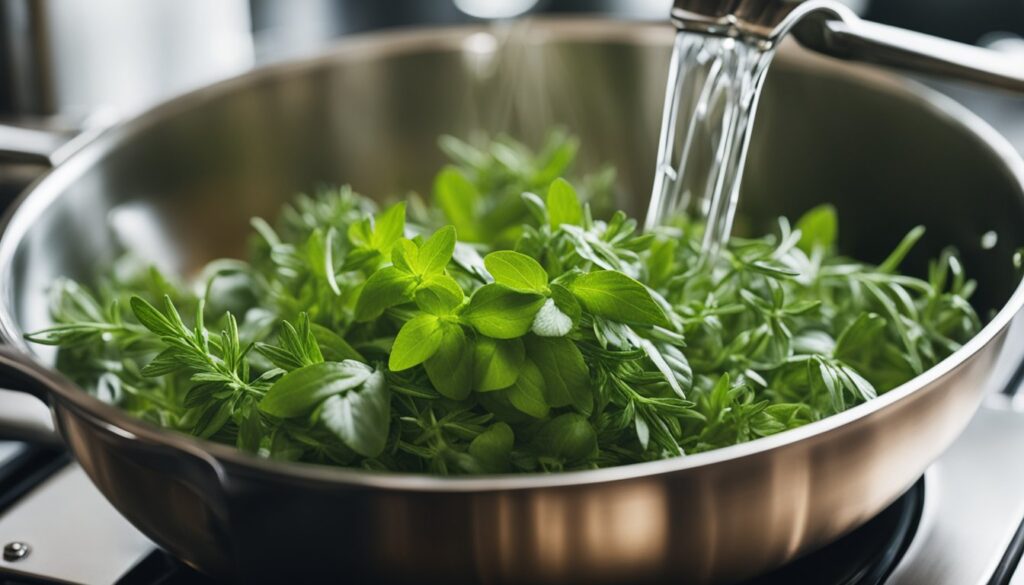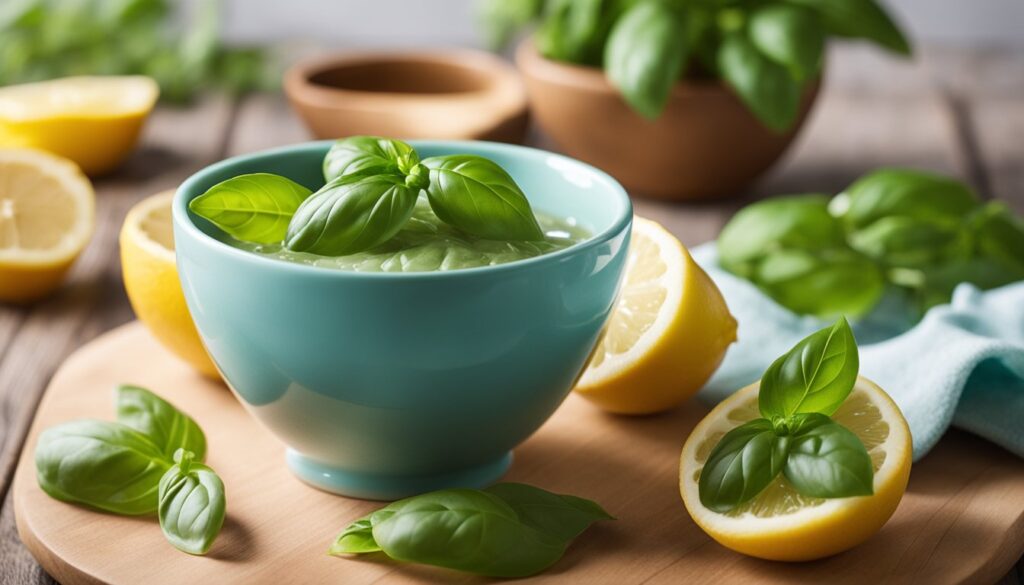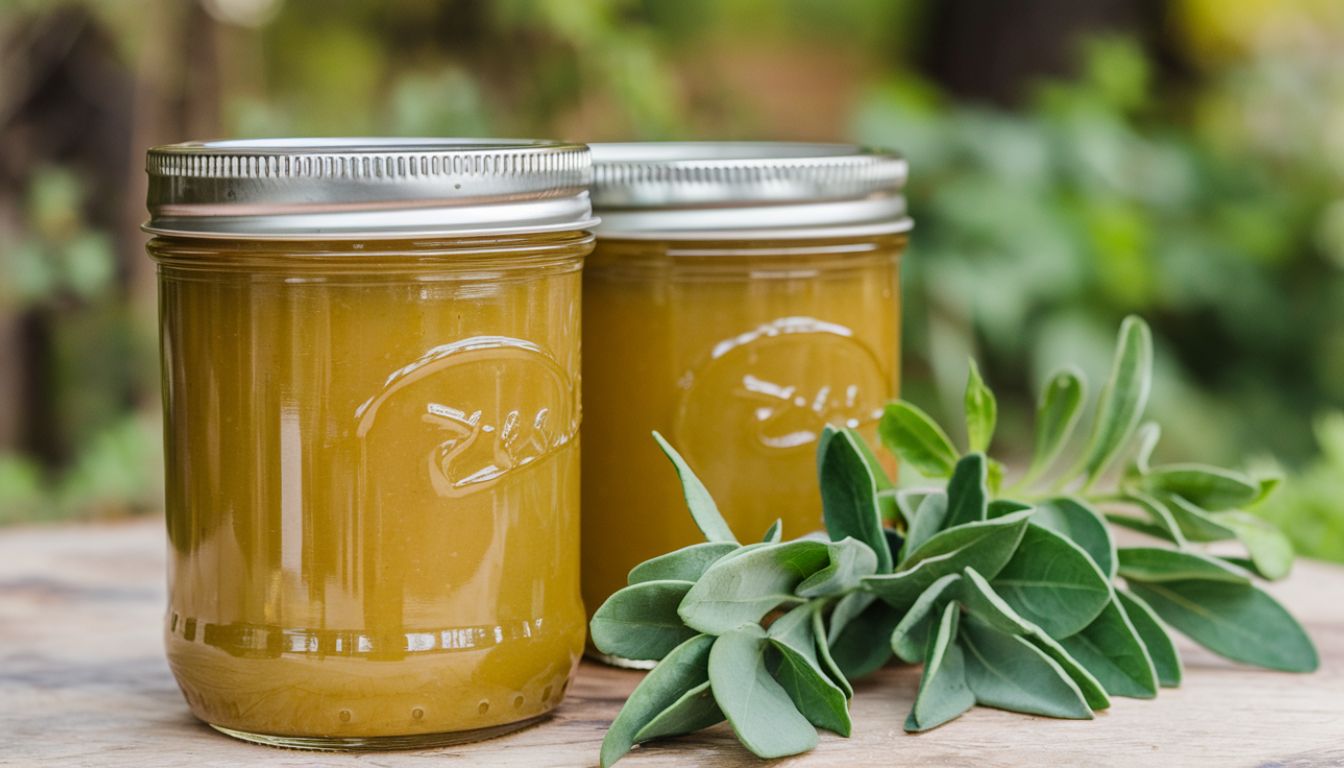Herb jelly is a tasty spread made from fresh herbs and flowers. It can be sweet or savory, and it adds flavor to many dishes. This guide will show you how to make herbal jelly, from picking the right herbs to making the jelly.
Understanding Herbal Jelly
Herbal jelly is a special spread that can be sweet or savory. It adds flavor to many dishes, making them taste better.
Sweet vs. Savory Herbal Jellies
Sweet herbal jellies use herbs like lavender, mint, and lemon balm. They are great for desserts and breakfast. Savory herbal jellies use herbs like thyme, rosemary, and basil. They go well with meats, cheeses, and appetizers.
Health Benefits of Specific Herbs: Jelly with a Side of Wellness
When you think of herb jelly, you might picture a delightful spread on your toast or a fancy addition to your cheese platter. But here’s a fun twist: these jellies can also pack a punch when it comes to health benefits! It’s like having your cake and eating it too, except in this case, it’s jelly and wellness. Let’s dive into the health perks of some popular herbs you might consider for your sweet or savory creations.
Mint: The Digestive Dynamo – Herb Jelly
Ah, mint—the refreshing herb that can turn a simple glass of water into a spa-like experience. But did you know it’s also a champion for your digestive health? That’s right! Mint has been used for centuries to soothe upset stomachs and alleviate bloating. It’s like having a tiny, green superhero fighting off discomfort in your belly.
Imagine enjoying a luscious mint jelly with your lamb chops or drizzling it over a fresh fruit salad. Not only does it taste amazing, but it also helps your digestive system work its magic. So, the next time you indulge in mint jelly, just think of it as a delicious way to keep your tummy happy!
Thyme: The Antibacterial Ally
Thyme isn’t just a culinary darling; it’s also a powerhouse of health benefits! This herb has been revered for its antibacterial properties, making it a great ally for keeping those pesky germs at bay. It’s like having a tiny army of defenders ready to protect your body.
When you whip up a savory thyme jelly, you’re not only enhancing your dishes but also giving your immune system a little boost. Picture a cozy evening with thyme jelly on a cheese platter, paired with some hearty crackers. You’ll be enjoying a delightful snack while knowing you’re doing something good for your health. Who knew snacking could be so virtuous?
Lavender: The Calming Companion – Herb Jelly
Lavender is often associated with relaxation and tranquillity, and for good reason! This lovely herb is known for its calming effects, making it a popular choice for reducing anxiety and promoting better sleep. Imagine spreading a layer of lavender jelly on your toast before bedtime—it’s like a lullaby for your taste buds!
Incorporating lavender into your diet through jelly can be a delightful way to harness its soothing properties. So, whether you’re enjoying it with breakfast or as a sweet treat after dinner, you can savor the flavor while reaping the calming benefits. It’s a win-win situation!
Rosemary: The Memory Booster
Rosemary isn’t just for roasts; it’s also a brain booster! This aromatic herb is believed to enhance memory and concentration. It’s like giving your brain a little pep talk while you enjoy your meal.
Imagine slathering rosemary jelly on a slice of crusty bread while studying for an exam or working on a project. Not only will you be nourishing your body, but you might also find yourself remembering those crucial details a bit better. Who knew that a little herb could help you ace your next quiz?
Basil: The Anti-Inflammatory Wonder – Herb Jelly
Basil is more than just a pizza topping; it’s a culinary superstar with anti-inflammatory properties. This herb can help combat inflammation in the body, which is a common culprit behind many health issues. So, when you create a savory basil jelly, you’re not just adding flavor; you’re also giving your body a helping hand.
Picture a warm summer evening with basil jelly drizzled over grilled vegetables or a charcuterie board. You’re enjoying a delicious meal while also supporting your body’s health. It’s like a secret health boost wrapped up in a tasty treat!
The Bottom Line: Flavor Meets Function
So there you have it! The world of herbal jellies is not just about tantalizing flavors; it’s also about embracing the health benefits that come along for the ride. Whether you’re whipping up a sweet lavender jelly or a savory thyme concoction, you’re infusing your meals with both taste and wellness.
Ingredients and Tools Needed – Herb Jelly

To make herbal jelly, you need fresh or dried herbs, pectin, lemon juice, and sugar for sweet jellies. For savory jellies, you need vinegar. You also need a saucepan, cheesecloth, and jars.
Choosing the Right Herbs – Herb Jelly
Picking the right herbs is important for the flavor of your jelly. For sweet jellies, use lavender, mint, and lemon balm. For savory jellies, use thyme, rosemary, and basil.
Essential Kitchen Tools
Having the right tools makes jelly-making easier. Make sure you have a saucepan, cheesecloth, and jars ready.
Step-by-Step Guide to Making Herbal Jelly
Preparing the Herbal Tea Base
First, make a herbal tea base with your herbs. Boil water and pour it over the herbs. Let them steep to release their flavors.
Cooking and Setting the Jelly
Mix the herbal tea with lemon juice, pectin, and sugar or vinegar. Boil the mixture, add sugar, and boil again until it thickens.
Storing and Preserving Your Jelly
Pour the jelly into jars, leaving some space at the top. Seal the jars and store them in a cool, dark place.
Detailed Flavor Profiles: The Symphony of Herbal Jellies
When it comes to making incredible herb jelly, understanding the flavor profiles of your chosen herbs is like being a conductor of a culinary orchestra. Each herb plays its unique note, and together, they create a delicious harmony that can elevate your jelly from ordinary to extraordinary. Let’s dive into the delightful world of flavors and discover how to choose the perfect herbs for your sweet or savory jelly masterpiece.
Sweet Herbal Delights – Herb Jelly
Imagine spreading a luscious lavender jelly on a warm scone, or drizzling mint jelly over a scoop of vanilla ice cream. Sweet herbal jellies can be a delightful treat, and the right herbs can transform a simple spread into a gourmet experience.
Lavender, for example, is like that charming friend who brings a touch of elegance to any gathering. Its floral notes are delicate and soothing, reminiscent of a sunny garden in full bloom. When infused into a jelly, lavender adds a subtle sweetness and a hint of perfume that can elevate desserts to new heights. Pair it with lemon for a zesty twist, and you’ve got a jelly that sings with freshness!
Mint, on the other hand, is the life of the party. It’s bright, refreshing, and invigorating—think of it as a cool breeze on a hot summer day. Mint jelly can add flavor to everything from yogurt to fruit salads. Imagine a mint-infused jelly swirling into your morning oatmeal, giving it a refreshing kick that wakes your taste buds. It’s like a mini-vacation in every bite!
Lemon balm is another gem in the sweet herbal jelly repertoire. Its citrusy aroma and mild flavor is like a sunbeam captured in a jar. This herb brings a gentle sweetness with a hint of lemon, making it perfect for jellies that pair beautifully with breakfast pastries or as a topping for creamy desserts. Just picture a dollop of lemon balm jelly on a slice of cheesecake—pure bliss!
Savory Herbal Wonders – Herb Jelly
Now, let’s flip the script and explore the savory side of herb jellies. These jellies are like the sophisticated cousins of their sweet counterparts, ready to elevate your charcuterie boards and savory dishes.
Thyme is a classic choice for savory jellies, and it’s like that dependable friend who always shows up when you need them. With its earthy, slightly minty flavor, thyme jelly can complement roasted meats, cheeses, and even grilled vegetables. Imagine slathering thyme jelly on a warm baguette with a slice of sharp cheddar—now that’s a flavor combination that can make your taste buds dance!
Rosemary, with its robust and piney notes, is another fantastic option. This herb has a bold personality, adding depth and warmth to your jelly. Rosemary jelly pairs wonderfully with lamb, making it a perfect accompaniment for a fancy dinner party. Just think of it as the secret ingredient that takes your dish from ordinary to extraordinary, like a well-tailored suit that turns heads at a gala.
Basil, the superstar of Italian cuisine, brings a sweet and slightly peppery flavor to the table. Basil jelly can be a game-changer when it comes to appetizers. Imagine serving it alongside a creamy goat cheese spread or drizzling it over bruschetta topped with fresh tomatoes. It’s like a summer garden on a plate, bursting with vibrant flavors that transport you straight to Italy.
Crafting Your Unique Blend
Now that you have a sense of the flavor profiles, it’s time to get creative! Think of your jelly-making adventure as a fun experiment in flavor. Don’t be afraid to mix and match herbs to create your unique blend. For example, combining mint and basil can yield a refreshing jelly that’s perfect for summer picnics, while a mix of lavender and rosemary can create a sophisticated jelly that pairs beautifully with grilled meats.
The key is to taste as you go. Let your palate guide you, and remember that making herb jelly is all about balancing flavors. Whether you’re leaning towards sweet or savory, the world of herbal jellies is your oyster—so dive in and enjoy the process!
In the end, understanding the flavor profiles of your herbs will not only help you create incredible jelly but also allow you to impress your friends and family with your newfound culinary skills.
Troubleshooting and Tips – Herb Jelly
Making jelly can be tricky. Here are some tips to help you get it right.
Common Jelly-Making Mistakes
Avoid overcooking or undercooking the jelly, as it affects texture and flavor.
Before You Go – Herb Jelly

Use these tips to make sure your herbal jelly turns out well every time.
Frequently Asked Questions: Your Herb Jelly Queries Answered!
So, you’re ready to dive into the delightful world of herb jelly, but maybe you’ve got a few questions swirling around in your mind like a curious bee buzzing from flower to flower. Don’t worry! I’ve got you covered. Let’s tackle some of the most common questions about making incredible herb jelly, so you can feel like a jelly-making pro in no time.
How Do I Adjust the Sweetness Levels?
Ah, the sweet spot! Finding the perfect balance of sweetness in your herb jelly can be a bit like trying to find the right amount of sugar in your morning coffee—too little and it’s bitter, too much and it’s cloying. If your jelly ends up too sweet, don’t panic! You can always add a splash of lemon juice or a bit of vinegar to cut through the sweetness. Think of it as giving your jelly a little zing!
On the flip side, if your jelly isn’t sweet enough, you can always stir in a little more sugar while it’s still warm. Just remember to taste as you go. It’s all about finding that delicious balance that makes your taste buds do a happy dance!
What If My Jelly Doesn’t Set?
Picture this: you’ve followed the recipe, your kitchen smells amazing, and you’re all set to enjoy your homemade herb jelly. But wait—your jelly is more like a syrup! Don’t let this jelly mishap ruin your day. It happens to the best of us. If your jelly doesn’t set, it might be because it didn’t reach the right temperature or there wasn’t enough pectin.
Fear not! You can rescue it. Simply pour the jelly back into a saucepan, add a bit more pectin, and re-boil it. It’s like giving your jelly a second chance at life! Just be sure to follow the pectin package instructions for the right amounts. And remember, patience is key. Good things come to those who wait—especially when it comes to jelly!
Can I Substitute Pectin?
Ah, pectin—the magical ingredient that helps your jelly achieve that perfect, spreadable consistency. But what if you’re out of pectin or want to try something different? No worries! You can use alternatives like agar-agar or gelatin. Just keep in mind that these substitutes may require different preparation methods.
If you’re feeling adventurous, you can also try making your pectin from apple cores and peels. It’s a bit like a science experiment in your kitchen! Just simmer those apple scraps in water, strain, and voilà! You’ve got homemade pectin ready to go. Talk about a zero-waste approach!
How Long Will My Herb Jelly Last?
Once you’ve made your delicious herb jelly, you’ll want to savor it for as long as possible. Properly sealed jars of jelly can last up to a year if stored in a cool, dark place. Just think of it as a little jar of sunshine waiting to brighten your day. However, once you open a jar, it’s best to consume it within a few weeks.
If you notice any weird smells, colors, or mold, it’s best to toss it. Better safe than sorry, right? After all, no one wants a jelly disaster on their hands!
Can I Use Dried Herbs Instead of Fresh?
Absolutely! While fresh herbs bring a vibrant flavor and aroma to your jelly, dried herbs can work just as well. Just remember that dried herbs are more concentrated, so you’ll need less. A good rule of thumb is to use about one-third of the amount of dried herbs compared to fresh.
Think of it as a flavor concentration game—dried herbs are like the espresso version of your favorite coffee, packing a punch in every spoonful!
How Can I Get Creative with Flavors?
Oh, the possibilities are endless! Don’t be afraid to let your imagination run wild. You can mix herbs, add spices like ginger or chilli flakes, or even incorporate fruits like berries or citrus for a delightful twist. It’s like being an artist with a palette of flavors at your fingertips.
Try combining sweet and savory herbs for an unexpected flavor explosion. Who knows? You might just stumble upon your new favorite jelly creation!
Herb Jelly
Ever tried making herb jelly? It’s a delightful twist on your usual spreads! Imagine a dollop of basil jelly on your toast or a spoonful of rosemary jelly with your cheese. These jellies are not only tasty but also a fantastic way to preserve your herbs. Plus, they make great gifts! For more fun and flavorful herbal recipes, visit The Herb Prof.
References – Herb Jelly
Little Herb Encyclopedia, by Jack Ritchason; N.D., Woodland Publishing Incorporated, 1995
The Ultimate Healing System, Course Manual, Copyright 1985, Don Lepore
Planetary Herbology, Michael Tierra, C.A., N.D., Lotus Press, 1988
Handbook of Medicinal Herbs, by James A. Duke, Pub. CRP Second Edition 2007
The Complete Medicinal Herbal, by Penelope Ody, Published by Dorling Kindersley
Check the Following Articles!
How To Make Herbal Salt Recipes: The Mega Guide
Herbal Remedies from Your Garden: All You Need To Know!

